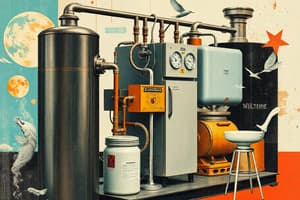Podcast
Questions and Answers
What happens when a weak solution of ammonia in water is heated?
What happens when a weak solution of ammonia in water is heated?
- Heating of only water
- No change in the solution
- Formation of ammonia vapor (correct)
- Formation of ice
In the absorber of an aqua-ammonia absorption refrigeration system, what is done with the strong and weak solutions?
In the absorber of an aqua-ammonia absorption refrigeration system, what is done with the strong and weak solutions?
- Strong solution is taken in and weak solution is given out
- Ammonia vapor from strong solution is extracted and made into a weak solution (correct)
- No action is taken on the solutions
- Weak solution is taken in and strong solution is given out
What advantage does using an analyzer-rectifier provide in an aqua-ammonia absorption system?
What advantage does using an analyzer-rectifier provide in an aqua-ammonia absorption system?
- It makes ammonia-water solution strong
- Both a and b (correct)
- It prevents expansion valve from blocking due to ice formation
- It has no advantages
For the same pressure, how does the saturation temperature of ammonia compare to that of water?
For the same pressure, how does the saturation temperature of ammonia compare to that of water?
What type of energy needs to be expended in a vapor absorption refrigeration system?
What type of energy needs to be expended in a vapor absorption refrigeration system?
In a refrigeration system, what is the correct equation to compute the air-side coefficient (hf) when the refrigerant temperature increases?
In a refrigeration system, what is the correct equation to compute the air-side coefficient (hf) when the refrigerant temperature increases?
What material is commonly used for the metal tubing of containers in refrigeration systems?
What material is commonly used for the metal tubing of containers in refrigeration systems?
Why is frost detrimental to the operation of refrigeration systems?
Why is frost detrimental to the operation of refrigeration systems?
When the refrigerant condenses at a constant pressure, in which portion of the condenser is its temperature constant?
When the refrigerant condenses at a constant pressure, in which portion of the condenser is its temperature constant?
In a water-type condenser's double pipe setup, where does the cold water flow?
In a water-type condenser's double pipe setup, where does the cold water flow?
How can the surface area of natural convection type condensers be compared to forced convection type condensers for the same capacity?
How can the surface area of natural convection type condensers be compared to forced convection type condensers for the same capacity?
In a hermetic reciprocating compressor, what happens when there is an increase in the evaporating temperature?
In a hermetic reciprocating compressor, what happens when there is an increase in the evaporating temperature?
What effect does a decrease in the water entering temperature have in a direct-expansion inner fin chiller?
What effect does a decrease in the water entering temperature have in a direct-expansion inner fin chiller?
What is the impact of an increase in the evaporating temperature on the refrigerating capacity in a direct-expansion inner fin chiller?
What is the impact of an increase in the evaporating temperature on the refrigerating capacity in a direct-expansion inner fin chiller?
How does an increase in water flow rate affect the refrigerating capacity in a direct-expansion inner fin chiller?
How does an increase in water flow rate affect the refrigerating capacity in a direct-expansion inner fin chiller?
Refrigeration capacity _______ with high ambient temperature.
Refrigeration capacity _______ with high ambient temperature.
At a certain condensing temperature, what happens to the heat rejection rate with high ambient temperature?
At a certain condensing temperature, what happens to the heat rejection rate with high ambient temperature?
What is the purpose of using the rectifier and analyzer components in the aqua-ammonia system?
What is the purpose of using the rectifier and analyzer components in the aqua-ammonia system?
When using ammonia as a refrigerant fluid, what material should the pipes be made from?
When using ammonia as a refrigerant fluid, what material should the pipes be made from?
In a vapor absorption refrigeration system with the same capacity as a vapor compression refrigeration system, how does the COP compare?
In a vapor absorption refrigeration system with the same capacity as a vapor compression refrigeration system, how does the COP compare?
How does the Coefficient of Performance (COP) of a vapor absorption system compare to that of a vapor compression system?
How does the Coefficient of Performance (COP) of a vapor absorption system compare to that of a vapor compression system?
In an absorption system, heat is added to the solution by which component?
In an absorption system, heat is added to the solution by which component?
Why is the work input requirement for an ammonia absorption refrigeration cycle low?
Why is the work input requirement for an ammonia absorption refrigeration cycle low?
Which equipment in an ammonia absorption plant requires cooling water?
Which equipment in an ammonia absorption plant requires cooling water?
In a vapor absorption refrigeration system, what are the temperatures at which heating, cooling, and refrigeration take place?
In a vapor absorption refrigeration system, what are the temperatures at which heating, cooling, and refrigeration take place?
What is the most common type of absorption refrigeration system used in industrial applications based on?
What is the most common type of absorption refrigeration system used in industrial applications based on?
In a Li-Br water absorption refrigeration system, what fittings are commonly made of?
In a Li-Br water absorption refrigeration system, what fittings are commonly made of?
Which refrigerants are used in aqua ammonia and Li-Br water refrigeration systems, respectively?
Which refrigerants are used in aqua ammonia and Li-Br water refrigeration systems, respectively?
Flashcards are hidden until you start studying
Study Notes
Heating Ammonia Solution
- When a weak solution of ammonia in water is heated, it releases ammonia gas.
Aqua-Ammonia Absorption Refrigeration System
- In the absorber, the strong and weak solutions are separated and recombined to maintain the refrigeration cycle.
Analyzer-Rectifier Advantage
- Using an analyzer-rectifier in an aqua-ammonia absorption system provides a higher concentration of ammonia, resulting in a more efficient refrigeration process.
Saturation Temperature Comparison
- The saturation temperature of ammonia is lower than that of water at the same pressure.
Energy Expenditure in Vapor Absorption Refrigeration
- Thermal energy needs to be expended in a vapor absorption refrigeration system.
Air-Side Coefficient Equation
- The correct equation to compute the air-side coefficient (hf) in a refrigeration system is hf = (T_r - T_a) / (T_r - T_w), where T_r is the refrigerant temperature, T_a is the ambient temperature, and T_w is the wall temperature.
Metal Tubing Material
- Copper is commonly used for the metal tubing of containers in refrigeration systems.
Frost Detriment
- Frost is detrimental to the operation of refrigeration systems because it reduces heat transfer and increases pressure drop.
Constant Temperature Portion
- When the refrigerant condenses at a constant pressure, its temperature is constant in the subcooling portion of the condenser.
Cold Water Flow
- In a water-type condenser's double pipe setup, the cold water flows through the inner pipe.
Condenser Surface Area Comparison
- The surface area of natural convection type condensers is generally larger than that of forced convection type condensers for the same capacity.
Hermetic Reciprocating Compressor
- When there is an increase in the evaporating temperature in a hermetic reciprocating compressor, the refrigerant flow rate increases.
Direct-Expansion Inner Fin Chiller
- A decrease in the water entering temperature in a direct-expansion inner fin chiller increases the refrigerating capacity.
- An increase in the evaporating temperature in a direct-expansion inner fin chiller decreases the refrigerating capacity.
- An increase in water flow rate in a direct-expansion inner fin chiller increases the refrigerating capacity.
Refrigeration Capacity and Ambient Temperature
- Refrigeration capacity decreases with high ambient temperature.
- At a certain condensing temperature, the heat rejection rate increases with high ambient temperature.
Rectifier and Analyzer Components
- The purpose of using the rectifier and analyzer components in the aqua-ammonia system is to separate and recombine the strong and weak solutions.
Pipe Material for Ammonia
- When using ammonia as a refrigerant fluid, the pipes should be made from steel or stainless steel to resist corrosion.
COP Comparison
- The Coefficient of Performance (COP) of a vapor absorption system is generally lower than that of a vapor compression system.
Heat Addition in Absorption System
- Heat is added to the solution by the generator component in an absorption system.
Work Input Requirement
- The work input requirement for an ammonia absorption refrigeration cycle is low due to the low pressure ratio.
Cooling Water Requirement
- The absorber and condenser equipment in an ammonia absorption plant require cooling water.
Temperature Ranges
- Heating, cooling, and refrigeration take place at temperatures of 80-120°C, 20-40°C, and -10 to 10°C, respectively, in a vapor absorption refrigeration system.
Common Type of Absorption Refrigeration System
- The most common type of absorption refrigeration system used in industrial applications is based on the aqua-ammonia system.
Fittings Material in Li-Br Water System
- Fittings in a Li-Br water absorption refrigeration system are commonly made of stainless steel or bronze.
Refrigerants Used
- Ammonia and lithium bromide (Li-Br) are used as refrigerants in aqua ammonia and Li-Br water refrigeration systems, respectively.
Studying That Suits You
Use AI to generate personalized quizzes and flashcards to suit your learning preferences.





